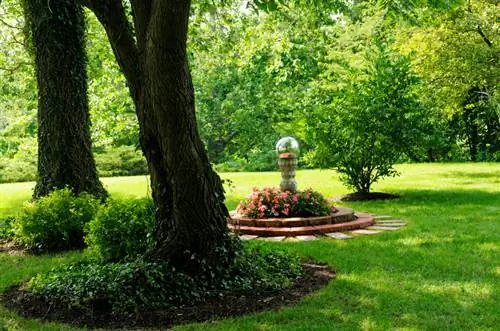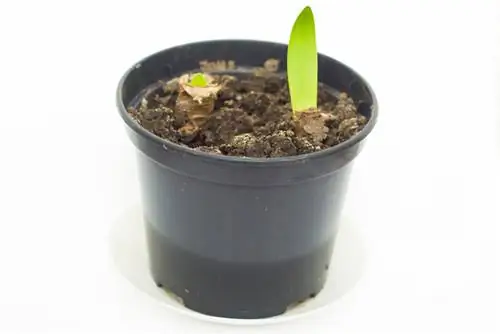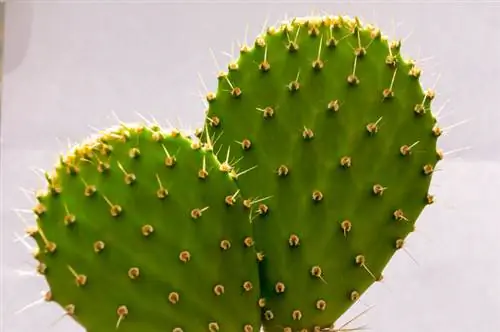- Author admin [email protected].
- Public 2023-12-16 16:46.
- Last modified 2025-01-23 11:22.
Working with a scythe is increasingly being forgotten, even though it offers numerous advantages. By choosing the optimal scythe and maintaining it regularly, work becomes child's play. A unique natural experience is guaranteed with this mowing technique.

What is important to work properly with a scythe?
When scything, it's all about choosing a suitable scythe, regular care through trimming, and adjusting the blade correctly. The ideal posture enables efficient and back-friendly mowing, the weather and growth determine the correct mowing date.
What you should know before buying a scythe
A scythe consists of a tree and an adjustable blade. The scythe tree takes on the task of transferring movement and force to the leaf cutting edge. This happens automatically if the scythe meets the basic requirements:
- Length: Scythe tree must fit body size
- Unity: The scythe tree and blade must be aligned and at the right angle
- Application: Scythe blade should be suitable for the planned mowing work

Metal or wood
Basically, the choice of material is of less importance if the scythe tree meets the requirements for gentle work. The best scythe trees are made from natural Krummholz. They have a high breaking strength because the fibers follow the path of the tree. Most scythes sold in stores are made of metal and are not suitable for people with a minimum height of 170 centimeters.
| Metal scythe tree | Wooden scythe tree | |
|---|---|---|
| Advantage | more stable and therefore suitable for rougher work | Can be made individually in any wood workshop |
| Disadvantage | limited adjustment options regarding the lower handle | expensive to buy |
Important dimensions
The length of the scythe tree describes the distance from the top handle to the scythe blade attachment. The correct tree length is primarily based on body size. In addition, the purpose has. an influence on the ideal measure. If the scythe is to be used on a flat surface, you can determine the correct tree length using a simple formula: subtract approximately 20 centimeters from your height. Tall people can deduct a little more, children less.
Short scythe trees are advantageous here:
- in cramped conditions
- when mowing on slopes and uneven terrain
- for participation in championships and competitions
If the scythe is perpendicular to the person, the overhand grip is ideally in front of the chin.
Scythe tree provider
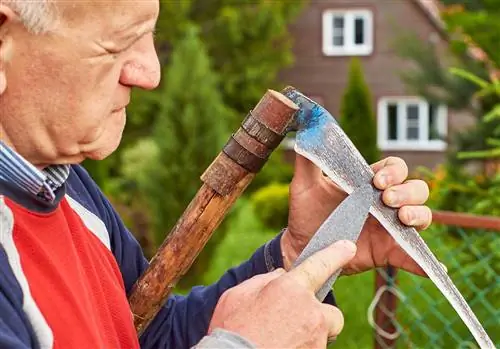
Handmade scythes are a rare commodity
Most hardware stores or garden centers offer modern metal scythe trees (€31.00 on Amazon) in standardized sizes between 140 and 150 centimeters. If you are 170 to 175 centimeters tall, such models are not sufficient. If you make a side swing with a scythe that is too short, you will have to lean forward unnecessarily. Tension and back pain occur. Scythe trees made from naturally grown wood are elaborately handcrafted by a few small businesses:
- Scythe workshop Lehnert in Gersheim-Walsheim
- Scythe workshop Mammern, Switzerland
- Silvanus Forstbedarf, Austria
Background
Crafts in danger of extinction
Tip
If there is little space or uneven terrain, a 50 or 65 mm scythe blade is recommended.
Before mowing
Before you can start mowing, some preparations need to be made. These enable optimal, efficient and body-friendly work.
Dengling scythes
When cutting, the front edge of the scythe blade is beaten thin to create a sharp cutting edge. Traditionally, dengel hammers and anvils are used. Alternatively, ordinary blacksmith anvils or modern dengel machines can be used. To make scythes, the blade is unscrewed from the scythe tree. The result is optimal if the cutting edge can be easily bent with your fingernail.
Rough instructions:
- Place the sheet in the middle and parallel to the anvil
- Guide your back with your left hand
- use right thigh as support
- Work from beard to tip stroke by stroke
Settings
The scythe blade must be adjusted before each work so that it does not bend when pressure is applied and always remains in its position. When you lay the scythe flat on the ground, the entire cutting edge must touch the ground. The distance between the tip of the scythe blade and the top of the scythe tree should be about two to six centimeters shorter than the distance between the base of the scythe blade and the end of the scythe tree.

Whetting
Regular sharpening of the cutting edge is of great importance not only before mowing but also during it so that you always get a clean cut. Place the scythe with the handle on the floor so that the tip of the sheet metal points to the right.
For more stability, place your right foot on the handle. After the blade has been cleaned, place the wet whetstone with the curved side on the cutting edge. Pull the whetstone outwards from the beard to the tip and then switch sides.
How to use the scythe correctly
Grass scything is a traditional craft that, when done correctly, allows for high efficiency and straight cuts. Nature conservation organizations such as NABU or clubs offer special courses in which you can learn how to scythe properly.
When to scythe
The ideal time depends on the weather and the growth of a meadow. Typical meadow herbs require light and are quickly shaded by tall grasses. Later cuts promote grass growth. Ideally, a conventional flower meadow is cut between the end of May and mid-June, when the flowering plants are in full bloom. Mowing with a scythe is an activity for early risers because dewy grass can be cut more effectively.
Posture
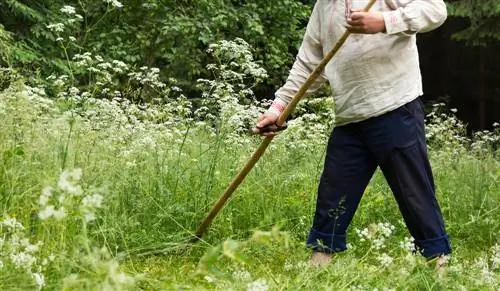
An upright posture is important so that your back doesn't hurt in the evening
An upright and relaxed posture is important. Execute each swing slowly and calmly. No special effort is necessary because the sharpened cutting edge cuts through the grass razor-sharp and leaves an even cut. Ideally, the scythe movement forms a circle.
Basic course on scythe mowing:
- Stand your legs slightly apart so that your right leg is a little further forward
- Upper body is upright while looking forward in the mowing direction
- Rotating movement comes from the hip
- Hamme should stay on the ground during the forward and backward swing
- move a step forward after one or two swings
Tip
Work your way up slopes in rows from bottom to top. The double mowing method is only suitable for flat meadows.
Frequently asked questions
What positive effects does scything have?
Scythes are operated by hand and prove to be a climate-friendly form of mowing. Since they don't have a motor, they don't put a strain on your hearing, which makes mowing with the scythe possible at any time. The controlled movements do not have a negative effect on the body and open up new experiences of nature. Small animals and insects are spared because they cannot get between the sharp blades of a mower. Species-rich hay meadows are promoted by the scythe cut, which increases the biodiversity of flora and fauna and pleases the eye of the beholder.
What do I need to scythe?
A scythe consists of a tree that has handles to guide the scythe. The scythe blade is attached to the lower end, which is between 60 and 80 centimeters long depending on the length of the tree. The curved blade is made of forged steel. The cutting edge is about five millimeters wide. In order to maintain the sharpness of the blade, the scythe blade should be sharpened regularly with a whetstone. This also happens during mowing. In order to keep the whetstone moist, it is stored in a whetstone holder.
What do you mean by dengel tableware?
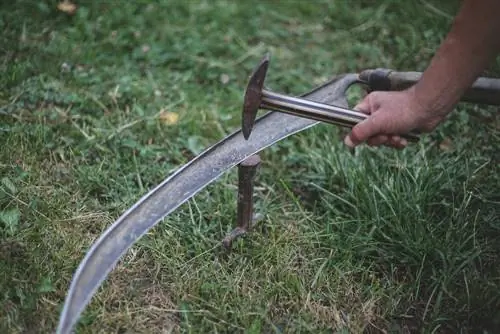
Dengeling is an art in itself
Dengling is a process for sharpening scythes and sickles. There is an indispensable step to ensure that mowing with a scythe does not become a sweaty affair. This technique is based on the art of blacksmithing and uses similar tools. The dengel tableware consists of a dengel hammer with a short handle and a dengel anvil. It is important that the striking surfaces of the anvil and hammer are slightly rounded on all sides. This means that only a small point on the cutting edge is hit when tapping and misses are not a problem.
What models of scythes are there?
There are different scythe blades for cutting meadows, perennials or bushes. Basically, the denser and woodier the area to be mowed, the shorter the scythe blade should be. On a normal hay meadow with plenty of space that is mown several times a year, you can make good progress with a leaf that is 80 to 90 centimeters long. If the growth offers resistance, you can achieve good results with a scythe blade of 70 to 80 centimeters. Woody bushes are cut with short leaves between 60 and 70 centimeters.
- Grass: long cutting blade with thin and sharp cutting edge
- Perennials: medium and robust scythe blade with wider cutting edge
- Scrubs: short cutting blade with wide cutting edge




